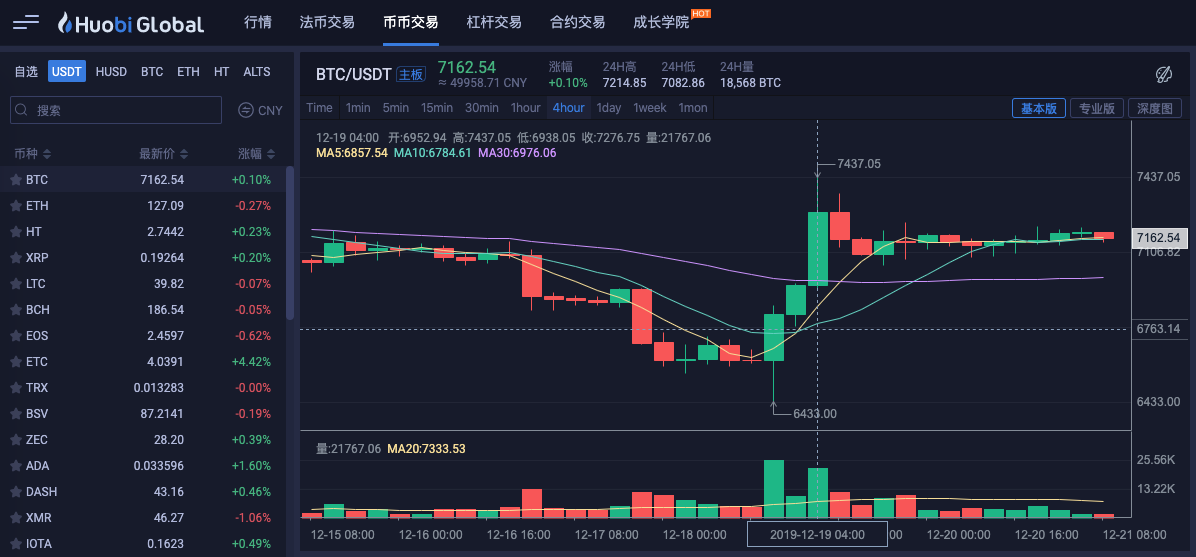Handshake teaches you how to write a K-line syntax in Python
Author: The Little Dream, Created: 2019-12-21 09:38:26, Updated: 2023-10-17 21:24:05
Handshake teaches you how to write a K-line syntax in Python
In writing, the policy is often used with some uncommonly used K-line cycle data. However, exchanges and data sources do not provide data for these cycles. It can only be synthesized using data that already has cycles.LinksIn the next step, we will write a Python version of the K-line synthesis algorithm.
The JavaScript version
function GetNewCycleRecords (sourceRecords, targetCycle) { // K线合成函数
var ret = []
// 首先获取源K线数据的周期
if (!sourceRecords || sourceRecords.length < 2) {
return null
}
var sourceLen = sourceRecords.length
var sourceCycle = sourceRecords[sourceLen - 1].Time - sourceRecords[sourceLen - 2].Time
if (targetCycle % sourceCycle != 0) {
Log("targetCycle:", targetCycle)
Log("sourceCycle:", sourceCycle)
throw "targetCycle is not an integral multiple of sourceCycle."
}
if ((1000 * 60 * 60) % targetCycle != 0 && (1000 * 60 * 60 * 24) % targetCycle != 0) {
Log("targetCycle:", targetCycle)
Log("sourceCycle:", sourceCycle)
Log((1000 * 60 * 60) % targetCycle, (1000 * 60 * 60 * 24) % targetCycle)
throw "targetCycle cannot complete the cycle."
}
var multiple = targetCycle / sourceCycle
var isBegin = false
var count = 0
var high = 0
var low = 0
var open = 0
var close = 0
var time = 0
var vol = 0
for (var i = 0 ; i < sourceLen ; i++) {
// 获取 时区偏移数值
var d = new Date()
var n = d.getTimezoneOffset()
if (((1000 * 60 * 60 * 24) - sourceRecords[i].Time % (1000 * 60 * 60 * 24) + (n * 1000 * 60)) % targetCycle == 0) {
isBegin = true
}
if (isBegin) {
if (count == 0) {
high = sourceRecords[i].High
low = sourceRecords[i].Low
open = sourceRecords[i].Open
close = sourceRecords[i].Close
time = sourceRecords[i].Time
vol = sourceRecords[i].Volume
count++
} else if (count < multiple) {
high = Math.max(high, sourceRecords[i].High)
low = Math.min(low, sourceRecords[i].Low)
close = sourceRecords[i].Close
vol += sourceRecords[i].Volume
count++
}
if (count == multiple || i == sourceLen - 1) {
ret.push({
High : high,
Low : low,
Open : open,
Close : close,
Time : time,
Volume : vol,
})
count = 0
}
}
}
return ret
}
There are JavaScript algorithms, which can be translated in Python in a line-by-line port, encountering JavaScript's built-in functions, or inherent methods, which can be used to find the corresponding method in Python, so porting is relatively easy.
The algorithm logic is exactly the same, just the function calls in JavaScriptvar n = d.getTimezoneOffset()When porting to Python, use Python's time library.n = time.altzoneOther differences are purely syntactical (e.g. use of for loops, difference in Boolean values, difference between logical and non-logical, logical or of etc.).
The Python code after the transplant:
import time
def GetNewCycleRecords(sourceRecords, targetCycle):
ret = []
# 首先获取源K线数据的周期
if not sourceRecords or len(sourceRecords) < 2 :
return None
sourceLen = len(sourceRecords)
sourceCycle = sourceRecords[-1]["Time"] - sourceRecords[-2]["Time"]
if targetCycle % sourceCycle != 0 :
Log("targetCycle:", targetCycle)
Log("sourceCycle:", sourceCycle)
raise "targetCycle is not an integral multiple of sourceCycle."
if (1000 * 60 * 60) % targetCycle != 0 and (1000 * 60 * 60 * 24) % targetCycle != 0 :
Log("targetCycle:", targetCycle)
Log("sourceCycle:", sourceCycle)
Log((1000 * 60 * 60) % targetCycle, (1000 * 60 * 60 * 24) % targetCycle)
raise "targetCycle cannot complete the cycle."
multiple = targetCycle / sourceCycle
isBegin = False
count = 0
barHigh = 0
barLow = 0
barOpen = 0
barClose = 0
barTime = 0
barVol = 0
for i in range(sourceLen) :
# 获取时区偏移数值
n = time.altzone
if ((1000 * 60 * 60 * 24) - (sourceRecords[i]["Time"] * 1000) % (1000 * 60 * 60 * 24) + (n * 1000)) % targetCycle == 0 :
isBegin = True
if isBegin :
if count == 0 :
barHigh = sourceRecords[i]["High"]
barLow = sourceRecords[i]["Low"]
barOpen = sourceRecords[i]["Open"]
barClose = sourceRecords[i]["Close"]
barTime = sourceRecords[i]["Time"]
barVol = sourceRecords[i]["Volume"]
count += 1
elif count < multiple :
barHigh = max(barHigh, sourceRecords[i]["High"])
barLow = min(barLow, sourceRecords[i]["Low"])
barClose = sourceRecords[i]["Close"]
barVol += sourceRecords[i]["Volume"]
count += 1
if count == multiple or i == sourceLen - 1 :
ret.append({
"High" : barHigh,
"Low" : barLow,
"Open" : barOpen,
"Close" : barClose,
"Time" : barTime,
"Volume" : barVol,
})
count = 0
return ret
# 测试
def main():
while True:
r = exchange.GetRecords()
r2 = GetNewCycleRecords(r, 1000 * 60 * 60 * 4)
ext.PlotRecords(r2, "r2")
Sleep(1000)
Testing
Chart of the coin market
Re-test the four hour chart
The above code is for learning reference only, and if used in a specific strategy, please modify and test as needed. If you have any bugs or suggestions for improvement, please leave a comment, thank you very much o^_^o
- Quantifying Fundamental Analysis in the Cryptocurrency Market: Let Data Speak for Itself!
- Quantified research on the basics of coin circles - stop believing in all kinds of crazy professors, data is objective!
- The inventor of the Quantitative Data Exploration Module, an essential tool in the field of quantitative trading.
- Mastering Everything - Introduction to FMZ New Version of Trading Terminal (with TRB Arbitrage Source Code)
- Get all the details about the new FMZ trading terminal (with the TRB suite source code)
- FMZ Quant: An Analysis of Common Requirements Design Examples in the Cryptocurrency Market (II)
- How to Exploit Brainless Selling Bots with a High-Frequency Strategy in 80 Lines of Code
- FMZ quantification: common demands on the cryptocurrency market design example analysis (II)
- How to exploit brainless robots for sale with high-frequency strategies of 80 lines of code
- FMZ Quant: An Analysis of Common Requirements Design Examples in the Cryptocurrency Market (I)
- FMZ quantification: common demands of the cryptocurrency market design instance analysis (1)
- Quantified trading tools for open-source digital currency options
- Handshake teaches you how to add support for multiple charts to a policy
homily/upload/asset/30da6ebb64b8003b1686.jpg Aha, Dream Dream Teacher is more technical than me.
homilyThe pyresample function is used to do this.
The Little DreamZhan, I don't know Python, I'm just a beginner.
The Little Dream666 is being studied.